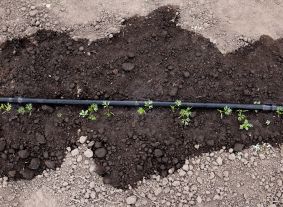New for 2012: AAS Pepper Cayennetta and Faerie Watermelon
Views: 3336

Less than a dozen days to Christmas. What can I get you for the holidays? A list of garden gadgets, tools, and toys for your gift-giving shopping list? Been there, done that. Another list of gardening books? That list is as common among garden writers as wishlists are among kids this time or year. What about some suggestions of vegetable crops to experiment with in your 2012 garden? I’d appreciate that as a gift. Let’s start with two that I have absolutely no experience with because they are THAT new to the market: the 2012 Vegetable Category winners from All-America Selections. If you’re not familiar with All-America Selections (AAS for short), it’s an organization that tests and trials annual flowers and vegetables grown from seed. They have test gardens throughout the country and a bevy of experienced judges who do the selecting. AAS, by the way, is celebrating its 80th anniversary in 2012, so they know what they’re doing.
Pepper Cayennetta
I like spicy peppers, and I especially like growing them in the garden. My ever-annoying pepper maggots seem to dislike them, so I end up with a good crop. AAS selected a spicy pepper, Pepper Cayennetta, as one of their two veggie winners. Cayennetta is mildly spicy, but not too overpowering, and it’s easy to grow. The peppers are about 3 to 4 inches long and are produced on a plant with an upright habit.
That’s key, because Pepper Cayennetta doesn’t need staking and propping up, as some other chili pepper plants do. Two of its unique characteristics are a tolerance for cold (meaning you can plant it out in the garden a bit earlier and harvest peppers longer) and a dense set of leaves covering the peppers, protecting them from sun scorch. They had me at cold tolerance. Can’t wait to try this variety.
AAS Faerie Watermelon
The second vegetable winner is a watermelon called Faerie. If you’re someone who likes different, then this is for you.
First, it has butter-yellow, thinly striped skin. Beautiful, really. Second, it doesn’t spread very far—just 11 feet—making it a good watermelon variety for smaller gardens like mine.
Each fruit (not sure how many it produces on average) is about 8 inches in diameter, weighs 4-6 pounds, and has sweet, crisply textured pink to red flesh. Faerie reportedly is disease and insect tolerant, as well. If it can stand up to that horrid squash vine borer, then it’s going in my garden, for sure. The utter failure of my melons this year isn’t discouraging me from trying again!
Where to find them
I said above that AAS is for plants grown from seed. True. But, keep in mind that you also can find these varieties as young plants at your local garden center. Let someone else deal with the seed growing if you prefer.
The rest of the list, I’ll see what worked well for me and a bunch of my gardening buddies from around the country and get back to you in Part 2.
Have yourself some happy and fruitful holidays.
Meet Ellen Wells
When you’re raised on a farm, you can’t help but know a thing or two about gardening. Ellen Wells is our expert on edible gardening.…
Ellen's Recent Posts

Asparagus






